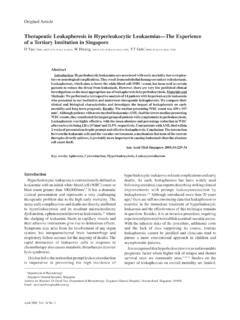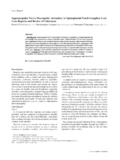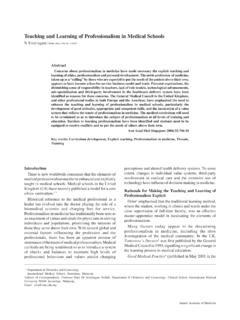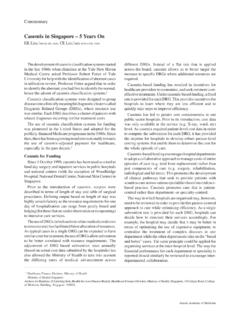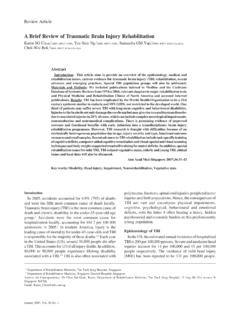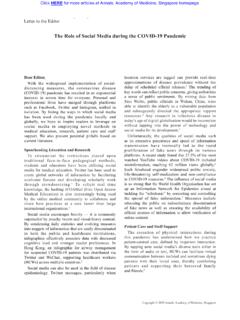Transcription of CLINICAL PRACTICE GUIDELINES Clinical …
1 186 Annals Academy of MedicineClinical indications for PET ScanningClinical indications for Positron Emission Tomography (PET) ScanningThe Workgroup for the Chapter of Radiologists, Academy of Medicine, SingaporeAddress for Correspondence: Dr Anthony S W Goh, Department of Nuclear Medicine, Singapore General Hospital, Outram Road, Singapore purpose of these GUIDELINES is to provide a broadframework for clinicians considering the use of positronemission tomography (PET) scanning for their imaging is a rapidly evolving field, with ongoingdevelopments in imaging technology, radiochemistry,isotope production, animal research and clinicalapplications. There is a need for regular review of theseguidelines, to incorporate new evidence and results ofscientific most diagnostic tests, meta-analyses or systematicreviews are not available for PET in every clinicalapplication.
2 Nonetheless, CLINICAL PRACTICE should be guidedby the best available evidence. Whilst some of the followingrecommendations are based on mature scientific evidence,others simply represent the current consensus of experts inthis of the published data on PET scanning refer tostudies using traditional PET scanners. Combined PET-computed tomography (CT) scanners became commerciallyavailable in 2002, and a wealth of new data will emergeover the next few years on the incremental value of fusingPET with CT images. Preliminary experience suggests afurther enhancement of diagnostic accuracy, impact onpatient management and outcome, and extension of usefulclinical applications, particularly in oncology PRACTICE . Asclinical PET services were introduced in Singapore only inmid-2003, all the currently installed scanners are PET radiotracer compounds will also emerge fromexperimental use into routine CLINICAL application.
3 Futureupdates to these GUIDELINES will need to keep pace withthese developments. In addition, as PET technology hasspread more recently in Asian countries, more scientificdata relevant to our disease context will need to be sought, for hepatocellular and nasopharyngeal research into these areas should therefore is not possible to be dogmatic or prescriptive aboutthe role of PET in a given CLINICAL situation, as this maydepend on CLINICAL factors, socio-economiccircumstances, patient attitudes and other factors. Theserecommendations should therefore not be interpretedas mandatory for compliance in every stated clinicalsituation. For ease of reference, the recommendationshave been classified into 3 categories:** Useful application for CLINICAL PET imaging.* Potentially useful application not indicatedroutinely, but may be helpful in individual cases,or there is currently limited data to prove cost-effectiveness.
4 # Not recommended at otherwise stated, routine CLINICAL PET imaging isdeemed to be performed with the glucose analog , in certain situations, other PET radiotracers areneeded, to visualise other metabolic processes. These arenot yet routinely available at most CLINICAL PET sites(including those in Singapore).The following recommendations are intended as a guidefor physician referral and patient selection for CLINICAL PETimaging. For more details on the scientific evidence, thereader is advised to refer to the publications in the and Spinal Cord Tumours(PET scanning using both 18F-FDG and 11C-methionine isrecommended.) Distinguishing residual or recurrent disease from post-therapy scarring or radionecrosis, when anatomicalimaging is difficult or equivocal.** Benign versus malignant lesions, where there isuncertainty on anatomical imaging and a relativecontraindication to biopsy, intra-cranial lymphomaversus toxoplasmosis.
5 ** Grading of primary brain tumours.* Evaluation of response to therapy.* Identifying site of recurrent brain tumour for biopsy.* PET is not recommended as a primary imaging tool forsuspected brain metastases.# CLINICAL PRACTICE GUIDELINESM arch 2004, Vol. 33 No. 2187 CLINICAL indications for PET ScanningHead and Neck Cancers (other than nasopharyngeal,thyroid cancer, or brain tumours) Staging.* Restaging.** Evaluation of suspected recurrence.** Evaluation of response to therapy.* Search for unknown primary tumour in patients withcervical nodal metastases.** For parotid tumours, however, PET is not helpful fordistinguishing benign from malignant pathology.#Nasopharyngeal Cancer Staging.* Restaging.** Localising or differentiating recurrence from therapy-induced radiological changes.** Evaluation of response to therapy.*Thyroid Cancer Detection of recurrent or residual tumour (follicular orpapillary cancer), when serum thyroglobulin is elevatedbut radioiodine scan is negative or appears tounderestimate the extent of disease.
6 ** Not recommended for routine assessment ofthyroglobulin-positive recurrence with radioiodineuptake.# Assessment of tumour recurrence in medullary carcinomaof the thyroid.*Parathyroid Adenoma Preoperative localisation of parathyroid adenomausing 11C-methionine, when other investigations arenegative.*Solitary Pulmonary Nodule Characterisation of a newly discovered indeterminatelung nodule, or a nodule that shows interval increase insize on chest X-ray or CT scan.**Non-small Cell Lung Cancer Staging.** Restaging.** Assessment of recurrent disease in previously treatedareas where anatomical imaging is unhelpful.** Evaluation of response to therapy.*Small Cell Lung Cancer Staging.*Breast Cancer Staging.* Restaging.* Evaluation of suspected recurrence, brachialplexopathy (radiation effects versus malignantinfiltration), when anatomical imaging results are non-diagnostic or equivocal.
7 * Evaluation of response to therapy.*Oesophageal Cancer Staging and restaging.** Suspected recurrent disease useful for distant lymphnodes and distant metastases, but of limited value fordetection of locoregional disease near to the primarytumour.** Evaluation of response to therapy.*Gastric Cancer Staging and restaging.*Gastrointestinal Stromal Tumour Evaluation of response to therapy.*Hepatocellular Carcinoma(This requires a dual-tracer technique using 18F-FDG and11C-acetate.) Staging.* Evaluation of response to therapy.*Pancreatic Carcinoma Staging of known primary pancreatic carcinoma.* Differentiation between benign and malignant pathology, chronic pancreatitis from pancreatic cancer.*Colorectal Cancer Staging.* Restaging.** Suspected recurrence, elevated serum markers,suspicious radiological changes, abnormal physical examor CLINICAL symptoms of recurrence.**Renal Cancer, Transitional Cell Carcinoma andBladder Cancer Limited data available for 18F-FDG PET in diagnosis andstaging.
8 A negative 18F-FDG PET does not rule outactive malignancy. Possible role for 11C-methionine and 11C-acetate Academy of MedicineClinical indications for PET ScanningProstate Cancer 18F-FDG PET is of limited value. Lower histologic gradetumours may not show FDG uptake. PET imaging with 11C-acetate, 11C-choline, 18F-fluoroacetate, or 18F-choline show promise for detectionof recurrence and metastases from prostate Cancer Evaluation of suspected recurrence.*Cervical Cancer Staging.* Restaging.* Evaluation of suspected recurrence.*Testicular Tumours Staging.* Restaging.* Evaluation of suspected recurrence.* Evaluation of response to therapy.*Lymphoma Staging.** Restaging.** Evaluation of response to therapy.** Evaluation of suspected tumour recurrence, tumourversus post-therapy fibrosis in a residual mass.** Assessing bone marrow involvement.*Malignant Melanoma Staging (Breslow > mm or known lymph nodeinvolvement).
9 ** Restaging.** Follow-up of patients with high-risk primary lesions.**Soft Tissue Sarcomas Diagnosis and grading.* Restaging.*Metastatic Cancer of Unknown Primary Cancer Detection of occult malignant disease.* Not indicated in widespread metastatic disease if PETresult will not influence management.#Paraneoplastic Syndrome Detection of unknown primary cancer.*CardiologyMyocardial Viability Cardiac FDG-PET imaging is recommended forassessment of myocardial viability in selected patientswith coronary artery disease and severely impaired leftventricular function, who are being considered forcoronary revascularisation or heart transplantation,especially in patients with equivocal or inconclusiveresults for viability based on myocardial perfusionSPECT, dobutamine stress echocardiography or cardiacmagnetic resonance imaging (MRI).**Myocardial Perfusion(Myocardial blood flow studies using 13N-ammonia or82Rb.)
10 Diagnosis for coronary artery disease when myocardialperfusion SPECT or other tests are equivocal.* Distinguishing ischaemic cardiomyopathy from othertypes of dilated cardiomyopathy.*NeurologyRefractory Epilepsy Inter-ictal FDG-PET is recommended for lateralisationof epileptogenic foci prior to surgical intervention inpatients with medically refractory epilepsy and whereinconclusive localising information is provided by astandard assessment, including seizure pattern,electroencephalography and MRI.** 11C-flumezanil may be helpful for localisation ofepileptogenic foci.*Dementia In the work-up of patients with dementia, FDG-PET ishelpful in identification of early Alzheimer s diseasebefore the onset of cerebral atrophy, especially in youngerpatients with dementia and normal MRI or CT.*Parkinson s Disease Confirmation of Parkinson s disease using 18F-DOPA when symptoms are atypical or mild.
